
Title
“Yakeato” no Sengo Kūkan Ron (Charred Ruins—A Discussion of Postwar Spaces)
Size
356 pages, 127x188mm, hardcover
Language
Japanese
Released
August, 2018
ISBN
978-4-7872-3439-1
Published by
Seikyusha
Book Info
See Book Availability at Library
Japanese Page
75 years are about to have passed since the end of the Asia-Pacific War in August 1945. The term “postwar” has been used for a long time to refer to this period. But for how long is the word “postwar” really valid? When one really thinks about it, a lot has happened in these 75 years. The era name, used in implicit support of the Emperor system, has changed from “Shōwa” to “Heisei,” and then again to a new era name, and the ruling Liberal Democratic Party has also transformed in phantasmagoric fashion. There have also been many natural disasters, and the economic situation is shifting rapidly. Looking at people’s lives, the illusion that everyone in Japan is middle class was blown away, social stratification has spread, and ways of life previously taken for granted have changed. Why do we try to describe a 75-year period in which there has been so much change with this single term, “postwar?” Or, perhaps the question could be paraphrased in this way: what do we attempt to overlook when everything is sugarcoated in the word “postwar?”
This book deals with the representation of urban space in Japan under US occupation after defeat in World War II. It focused discussion in particular on “yakeato” (charred ruins) and “black markets” that frequently emerge in narratives of the era immediately after the war. For a long time now “yakeato” and “black markets” have been referred to as the spaces from which “Postwar Japan” began. However, when considered properly, neither of these spaces suddenly appeared on August 15, 1945. “Yakeato” were the ruins of spaces hit by strategic bombing by the United States military, and “black markets” were a byproduct of a controlled economy that began in 1939. The more one looks at these spaces, the more one can see continuity, rather than a break from what came before. However, looking over the media discourse and critical discourse from then until the present, it becomes apparent that references to the continuity of these spaces has been carefully avoided. Rather, it could perhaps be said that the continuity of these spaces has been camouflaged for a long time so that they can be reinterpreted as Postwar Japan’s “ground zero.”
So what does this continuity expose? The reality that Japan has always been inseparably connected to wars in each period from the past and even into Japan’s so-called “postwar” era. The illusion of “peaceful Japan” can only exist by ignoring people who continue to suffer from these wars in many ways; even now, 75 years later, the word “postwar” is still used to cling to a narcissistic image of Japan. Accordingly, in order to break down the “postwar Japan” discourse, this book examines the relationship between “postwar Japan” and ongoing war (the Cold War), with reference to literature, cinema, and critical discourse immediately after defeat in World War II. I hope that you will pick up this book, and confirm the source of the empty “Japan-worship” that overflows from modern media.
(Written by: SAKASAI Akito / October 30, 2020)



